Monkfish
Lophius spp.
Called the poor man's lobster!
Advertisement
Monkfish Scientific Classification
- Kingdom
- Animalia
- Phylum
- Chordata
- Class
- Actinopterygii
- Order
- Lophiiformes
- Family
- Lophiidae
- Genus
- Lophius
- Scientific Name
- Lophius spp.
Read our Complete Guide to Classification of Animals.
Monkfish Conservation Status

Monkfish Facts
- Prey
- Crustaceans, fish, seabirds, otters
- Main Prey
- Fish
- Fun Fact
- Called the poor man's lobster!
- Biggest Threat
- Overfishing
- Most Distinctive Feature
- Large mouth and unique "lure" to attract prey
- Other Name(s)
- Goosefish, angler, fishing frogs, Lotte
- Habitat
- Oceans (generally found at 20-1,000 meter depths)
- Predators
- Sharks, swordfish, large skate species
- Diet
- Carnivore
- Number Of Species
- 7
View all of the Monkfish images!
Monkfish have one of the most unusual appearances in the animal kingdom, but are ferocious predators!
Monkfish are part of the genus Lophius and are found along the coasts of the Atlantic Ocean and also in Asia. Long a favorite food staple in European cooking, the monkfish’s popularity has risen in other regions such as the United States and Japan. Its sweet yet firm meat has been described as the “poor man’s lobster.” Monkfish have one of the most unusual appearances in the animal kingdom, but are ferocious predators! They lay on the bottom of the ocean and ambush fish attracted to an antenna that’s used as bait. Once fish draw near, the monkfish strikes quickly and can swallow fish that are nearly its own size!
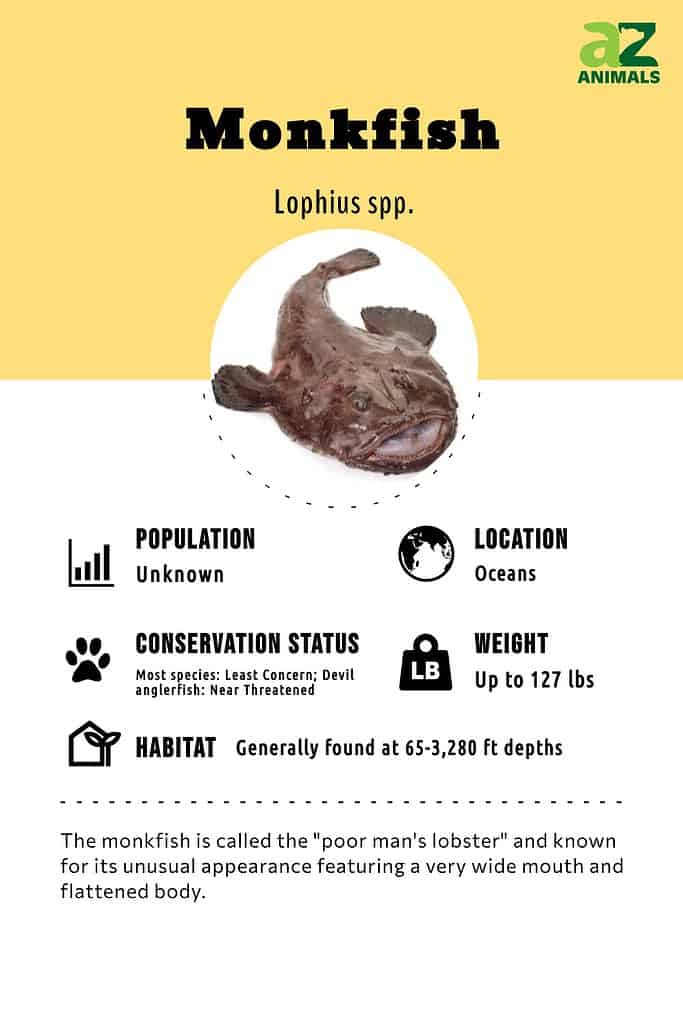
4 Amazing Monkfish Facts!
- It’s believed when monks asked for any unused fish at fishing markets, they were given this unappealing-looking fish that was often caught as a byproduct for their church to eat.
- The monkfish can even adapt its color to better camouflage and blend in with its surroundings!
- It is often called “the poor man’s lobster” as it tastes like lobster but costs a fraction of the amount.
- Scientists have discovered much more than fish inside the stomachs of monkfish. They’ve also found seabirds, ducks, and even otters!
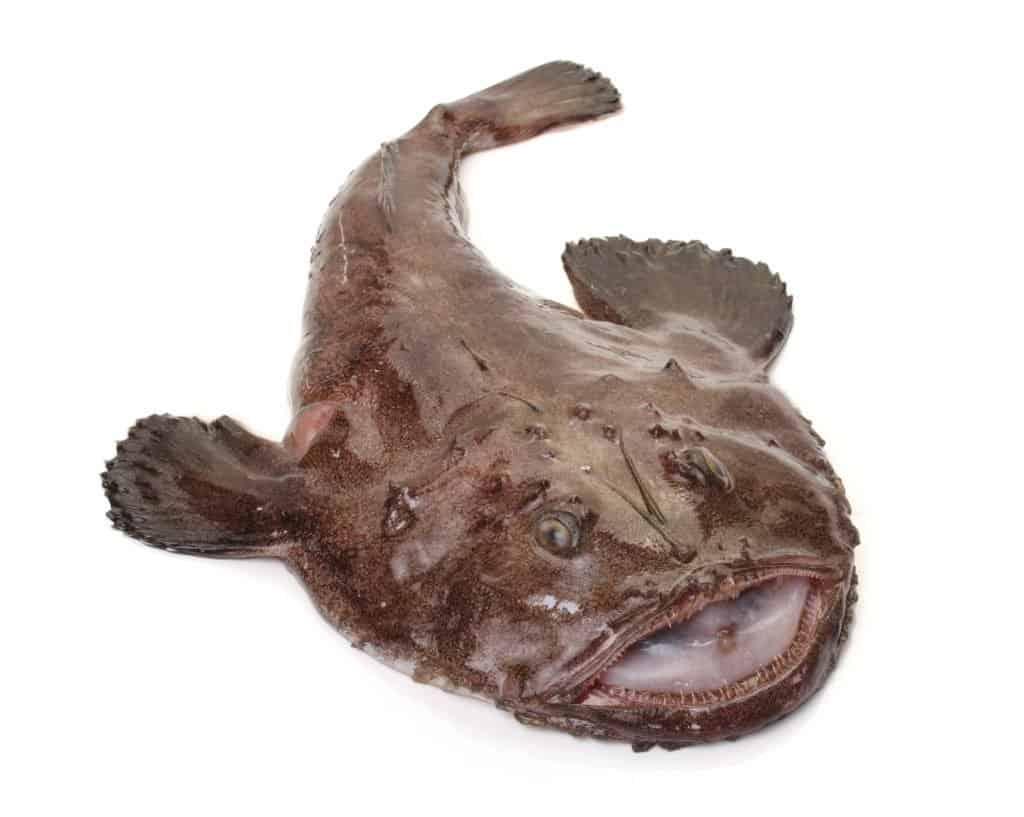
The monkfish can adapt its color to better camouflage itself.
©zcw/Shutterstock.com
Scientific Name
The monkfish belongs to the genus Lophius. The scientific name of the monkfish found off America’s Atlantic coast is Lophius Americanus.
Monkfish are part of the order Lophiiformes, or anglerfish. The order has 5 suborders, 17 families, 65 genera, and 300 species. The genus Lophius contains 7 species with similar appearances that are spread across the world. While all these species are sometimes referred to as “monkfish,” other common names include goosefish, fishing frogs, sea devils, angler, all mouth, abbot, and Lotte.
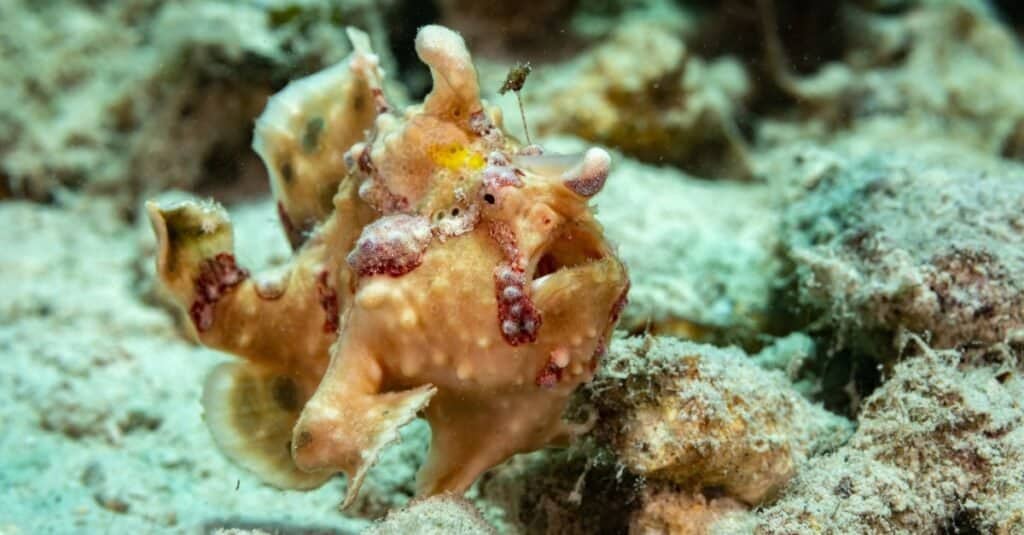
Monkfish are part of the anglerfish
Lophiiformesorder.
©Gerald Robert Fischer/Shutterstock.com
7 Types of Monkfish
Monkfish can be found around the world, and there are 7 distinct species in the genus Lophius. The 7 species of monkfish are:
- American angler (Lophius Americanus)
- Blackbellied angler (Lophius budegassa)
- Devil anglerfish (Lophius vomerinus)
- Shortspine African angler (Lophius vaillanti)
- Angler (Lophius piscatorious)
- Yellow goosefish (Lophius litulon)
- Blackfin goosefish (Lophius gastrophysus).
Each species of monkfish is described below.
| Geography | Scientific Name | Common Names | Description |
| Coastlines off America and Canada‘s Atlantic provinces | Lophius Americanus | American angler, goosefish | Lives at depths from 0 to 800 meters. Maximum recorded length of 47.2 inches (120 cm) and weight of 49.8 pounds (22.6 kilograms). |
| Coast of Morocco into the Mediterranean and the North Sea | Lophius budegassa | Blackbellied angler | Discovered at depths exceeding 1,000 meters. Reaches about 39 inches (100 cm) at maximum length. |
| From Namibia to South Africa’s Indian Ocean border | Lophius vomerinus | Devil anglerfish | Found mostly at a depth of 150 to 400 meters, the devil anglerfish is considered Near Threatened by the IUCN. |
| Coast of Africa from Senegal to Angola | Lophius vaillanti | Shortspine African angler | Maximum reported length of 31.6 inches (80.3 cm). |
| Waters surrounding Europe with a more northerly spread than the blackbellied angler | Lophius piscatorious | Angler | The largest species of monkfish, reaching 78.7 inches (200 cm) and weighing up to 127 pounds (57.7 kg). |
| Coastlines of China to Japan and Korea | Lophius litulon | Yellow goosefish | Reaches depths of 560 meters. Specimens have reached five feet (150 cm) in length. A popular high-end dish in Japan. |
| Mostly found in Caribbean waters down to Brazil | Lophius gastrophysus | Blackfin goosefish | Typically found at depths to 180 meters, but can reach 700. Maximum length of about two feet (60 cm). |
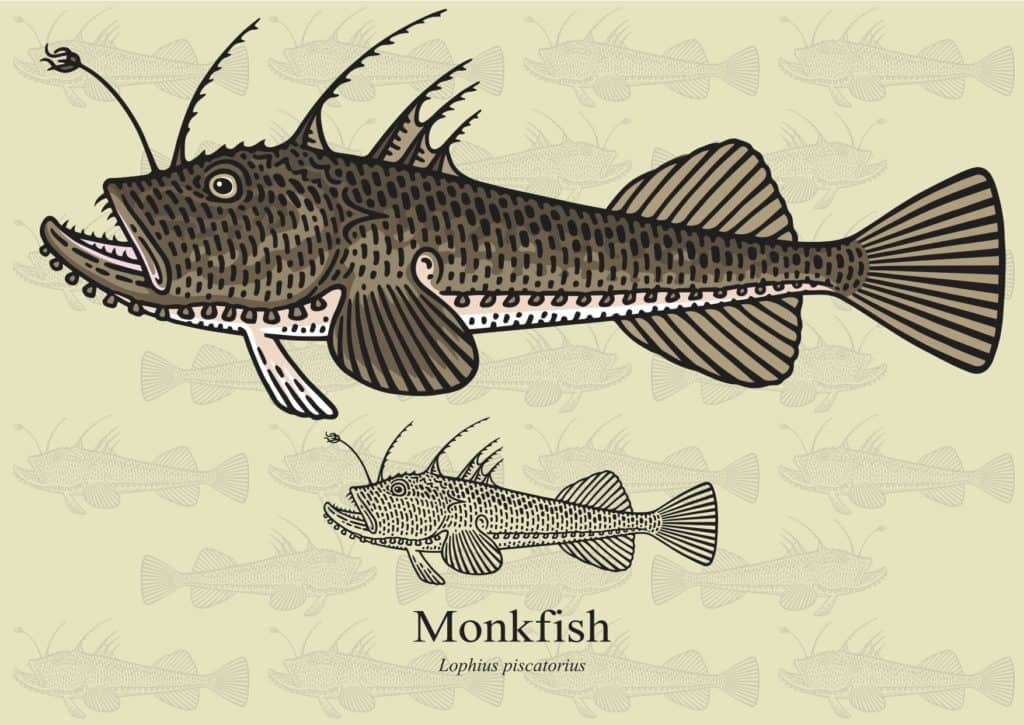
There are seven species of monkfish.
©The Fisherman/Shutterstock.com
Evolution and Origins
The evolutionary origins of this species are uncertain due to limited fossil records for the anglerfishes order Lophiiformes that the monkfish belongs to. A DNA study suggests Lophiiformes split between 130 million and 100 million years ago in the early to mid-Cretaceous period.
An extinct anglerfish species called Lophius brachysomus, a member of the same family Lophiidae as the monkfish, was described in 1835 in Italy and its extinction can be traced back to the middle Eocene 56 million to 33.9 million years ago.
Appearance and Behavior
Monkfish have an extremely unique appearance. Possessing extremely wide mouths and flattened bodies, as a member of the anglerfish order, monkfish have evolved so the spines on their dorsal fin function as “lures.”
They can move this spine in any direction, and a small fleshy piece on top helps move prey into an area where they can quickly strike. These bottom-dwelling fish are brown in color but have marbling that helps them blend in with the bottom of the seafloor.
Monkfish species grow to various sizes, with the angler reaching up to 127 pounds and 78.8 inches. Species in more temperate areas, such as the blackfin goosefish, are smaller and reach maximum sizes of roughly two feet in length.
Monkfish hunt by laying near the ocean floor similar to other bottom-dwelling fish like fluke fish. However, anglerfish have a unique adaptation: an antenna on top of their heads that’s moved to attract fish who are drawn to this “bait.” This technique allows the monkfish to use incredibly little energy as it simply waits for prey to come to it. Once prey is near, the monkfish strikes with lightning-fast speed and has a wide mouth that allows it to catch larger fish species. Its stomach can also stretch to accommodate larger prey that can exceed 50 pounds of weight!

The monkfish lurks for food on the sandy bottom of Osezaki, Japan.
©Martin Voeller/Shutterstock.com
Habitat
Monkfish are found on continental shelves, generally in waters between 65-3,280 feet depths (20 to 1,000 meters). Species of monkfish can be found off the Atlantic coasts of both North and South America, Europe, Africa‘s Atlantic coast, and from China to Japan in the Pacific.
Monkfish live in sand and sediment on the bottoms of oceans. Throughout the year their habitats will change as they migrate to spawn and find new food sources. Although monkfish is a highly valued fish in the Northeastern United States, there is still little known about its migratory patterns. A 2018 survey hypothesized monkfish migrated to deeper water during the summer to avoid warmer water temperatures.
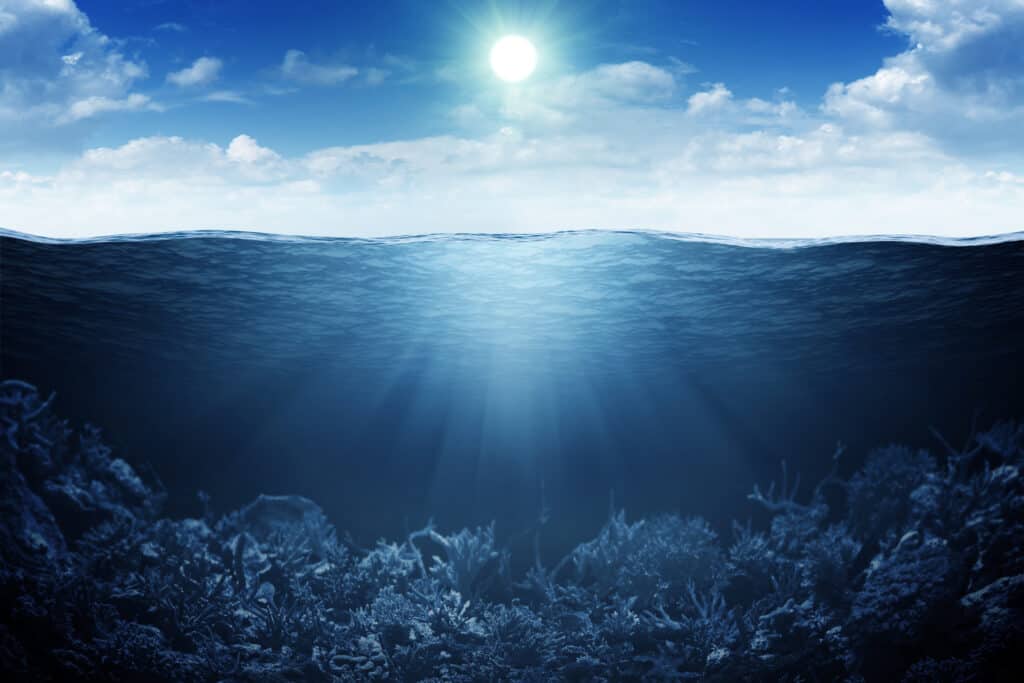
Monkfish live in sediment at the bottom of oceans.
©iStock.com/Korovin
Diet
The primary prey of monkfish changes with age. As larvae, they eat plankton, while juveniles feed on crustaceans and small fish. Once fully grown, monkfish feed predominately on larger fish. However, monkfish have been discovered with seabirds (such as the Little auk in Massachusetts) and even sea otters in their stomachs!
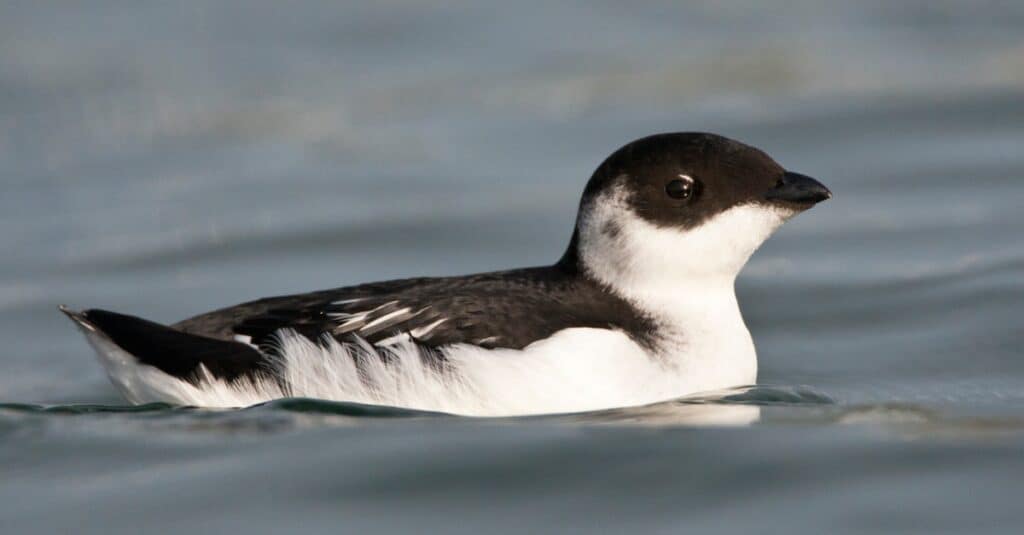
The monkfish has been known to feed on small, compact seabirds.
©iStock.com/AGAMI stock
Predators and Threats
As monkfish grow older they face few predators, however sharks, swordfish, and even skate fish will prey on monkfish when provided the opportunity.
People in many countries in Europe, Asia, and the United States eat monkfish and its meat has been described as the “poor man’s lobster.” The liver of the monkfish, which is known as ankimo, is a delicacy in Japanese cuisine.
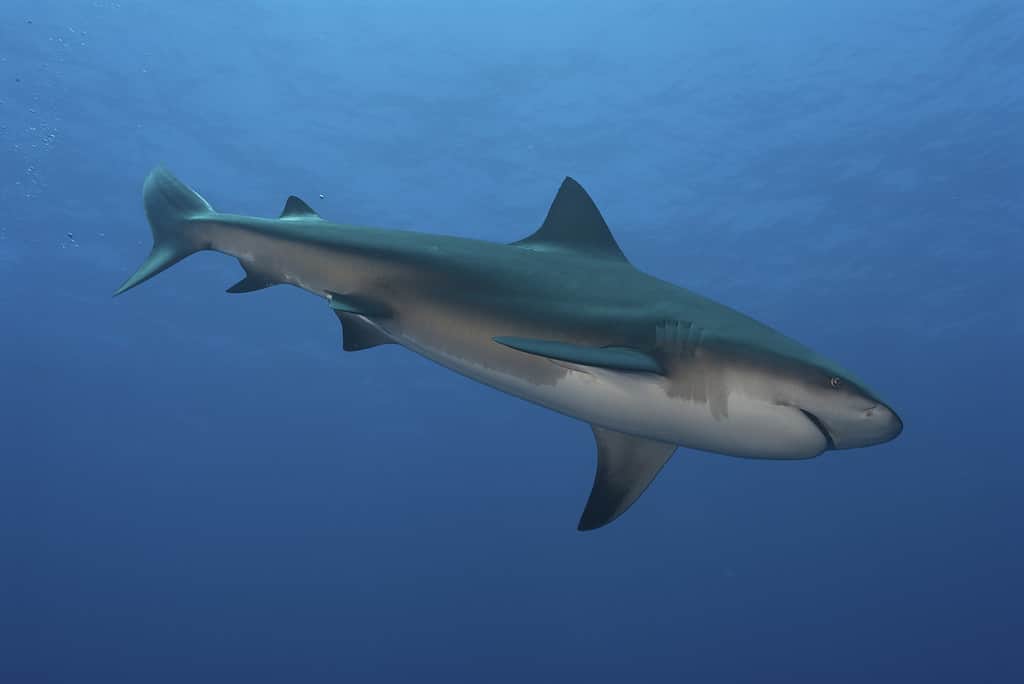
The shark preys upon monkfish when given the opportunity.
©iStock.com/FionaAyerst
Population and Conservation
Monkfish is rated as “sustainably managed” in the United States, but populations face threats in other regions of the world.
The National Oceanic and Atmospheric Administration’s most recent assessment of monkfish (American angler) biomass stands at about 197,280 metric tons. The species has been classified as Not Overfished and quotas have actually been raised to encourage more fishing of monkfish as its fishery has been sustainably managed. However, the devil anglerfish — which lives off the coast of South Africa and Namibia — has been classified as Near Threatened by the IUCN.

The IUCN classifies the devil anglerfish monkfish species as Near Threatened.
©Tobias Arhelger/Shutterstock.com
Monkfish Cooking and Fishing
Monkfish is an important fishery in both the United States and Europe. While there’s limited recreational fishing of the species, government agencies manage quotas. In recent years, the U.S. limit for monkfish has been raised to encourage fishermen to catch more of the species, as its stocks appear to be well-managed. The fish is caught through both trawling and gillnet gear.
Monkfish has long been a staple in French cuisine but has seen increased popularity in America. While monkfish have large heads, it’s the tail (and liver) that is edible and sold at fish markets. Tails on monkfish generally weigh between one and four pounds of dense meat lacking any bones.
The meat of monkfish is often compared to lobster because it has a slightly sweet character and a similarly firm texture. However, monkfish often costs much less than lobster. At Northeastern fish markets, monkfish tails will often cost $7 per pound vs. $10 or more for lobsters. This has led to monkfish being called “the poor man’s lobster.”
Many recipes call for monkfish to replace lobster. The dish is typically baked and then has added ingredients such as butter and lemon to provide additional flavor to the dish.
Monkfish is adaptable and is also used in a variety of soups and other preparations.
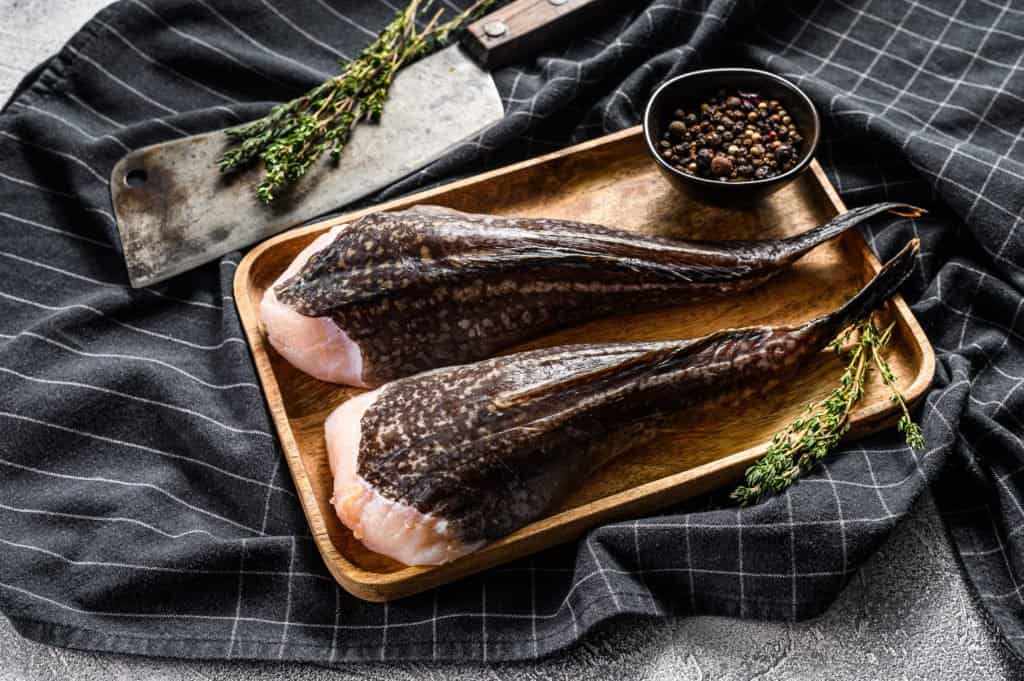
Monkfish tails typically have 1-4 pounds of dense, boneless meat.
©Mironov Vladimir/Shutterstock.com
Monkfish FAQs (Frequently Asked Questions)
What is a monkfish?
Monkfish are bottom-dwelling fish that are part of the anglerfish order. They have large mouths and flat bodies and rely on using a “lure” on the top of their head to ambush prey. Monkfish generally live at depths between 20 and 1,000 meters and are prized for the meat on their tails, which is comparable in taste and texture to a lobster.
What do monkfish taste like?
Monkfish have a slightly sweet taste and their tales possess dense meat. Both these qualities are similar to lobster and have led to monkfish being known as “the poor man’s lobster.”
What do monkfish smell like?
While monkfish are often called sea devils for their ‘monster-like’ appearance, they lack any unique smell. Their smell should be similar to other animals from the ocean. If a monkfish has a sour or especially pungent odor, the meat is likely expiring.
What kind of nutrition does monkfish have?
Per 100 gram serving monkfish has 76 calories. 18% of their calories are fat while the remainder is protein. The species has low saturated fat, measured at .3 grams per serving.
Where can you catch monkfish?
Monkfish are mostly fished by commercial vessels. The species tends to be in deeper environments where trawling or gillnets catch species like monkfish that reside near the bottom of the ocean. However, monkfish are sometimes seen near coastal waters. The species tends to migrate out into deeper waters during the summer when recreational fishing is most popular.
Are monkfish herbivores, carnivores, or omnivores?
Monkfish are carnivores, meaning they eat other animals.
What kingdom do monkfish belong to?
Monkfish belong to the kingdom Animalia.
What is another name for the monkfish?
The monkfish is also called the goosefish, angler, fishing frogs, or Lotte.
Thank you for reading! Have some feedback for us? Contact the AZ Animals editorial team.
Sources
- Seafood Source, Available here: https://www.seafoodsource.com/seafood-handbook/finfish/monkfish
- Liese A. Siemann , Carl J. Huntsberger, Jasper S. Leavitt, Ronald J. Smolowitz, Available here: https://journals.plos.org/plosone/article?id=10.1371/journal.pone.0206829
- Seafood from Norway, Available here: https://fromnorway.com/seafood-from-norway/monkfish/
- Washington Post, Available here: https://www.washingtonpost.com/national/energy-environment/ugly-delicacy-industry-touts-weird-looking-monkfish/2018/03/01/2741289e-1d79-11e8-98f5-ceecfa8741b6_story.html
- Fishbase, Available here: https://www.fishbase.in/summary/Lophius-piscatorius.html
















